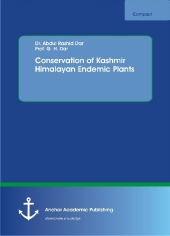 Neuerscheinungen 2017Stand: 2020-02-01 |
Schnellsuche
ISBN/Stichwort/Autor
|
Herderstraße 10
10625 Berlin
Tel.: 030 315 714 16
Fax 030 315 714 14
info@buchspektrum.de |

Abdul Rashid Dar, G. H. Dar
(Beteiligte)
Conservation of Kashmir Himalayan Endemic Plants
2017. 48 S. 39 Abb. 220 mm
Verlag/Jahr: ANCHOR ACADEMIC PUBLISHING 2017
ISBN: 3-9606711-0-5 (3960671105)
Neue ISBN: 978-3-9606711-0-7 (9783960671107)
Preis und Lieferzeit: Bitte klicken
Although a compendium of the extent of endemism in the Himalaya is not known, it is believed that the majority of dicot endemic species of India are concentrated in the Himalaya. A significant proportion of the Kashmir Himalayan endemics are endangered due to a multitude of factors and several of them are now listed in the Red Data Books at regional, national and international levels.
For this study, ex situ conservation efforts were attempted by raising plants of some economically important, critically endangered endemic angiosperms species of the Kashmir Himalaya from rhizomes, seeds or other reproductive propagules in the experimental plot at Kashmir University Botanical Garden (KUBG). Nine species belonging to 9 genera and 7 families were dealt with. The paucity of critical information necessitated the present study to explicate the macro-level factors constraining the populations of the target species through extensive field survey trips, and also to undertake measures for ex situ propagation and conservation in order to support their recovery and restoration and provide long-term backup collections for sustained use by the local populace.
Text Sample:
Chapter 5. MATERIALS AND METHODS:
Preparation of land:
A portion of land in the Kashmir University Botanical Garden (KUBG) was selected for the purposes of this project. In this experimental plot, many beds (approx. 8ft x 4ft) were prepared for growing the target endemic plant species.
Field surveys:
A proper procedure was followed for organizing field survey trips. Detailed scanning of all the relevant literature, guidance of experienced persons, and knowledge from the local tribals were used to obtain relevant information regarding the distribution, appropriate sites, local names, etc. of the target species. Legal permission was requested from the concerned Govt. and military authorities with respect to the prevailing security scenario in the State. Equipped with the tents, collection tools, etc. field survey team was deported from the Kashmir University campus to the designated survey areas.
Specimen processing and taxonomic description:
The target species collected, were identified and taxonomically described using the available literature and the specimens of these species (if any) available in the KASH. Usually a few specimens from each locality of occurrence of these species were collected and processed for herbarium purposes. The specimens were prepared into vouchers using standard herbarium methodology (such as pressing, drying, preservation, etc.). They were assigned specific numbers, depending upon the locality from where they have been collected. Species description, include author citation, diagnostic characters, habitat, and specimens examined.
Seed biology:
Seed biology/germination studies on some species were undertaken. The seeds of Lagotis cashmeriana, Meconopsis latifolia, Megacarpaea polyandra, and Saussurea costus were put to several treatments, including scarification, pricking, distilled water, light, dark, and to various concentrations of gibberellic acid (2mM, 1.5mM, 1mM, 0.5mM, 0.25mM, 0.125mM); potassium nitrate (2mM, 1.5mM, 1mM, 0.5mM, 0.25mM, 0.125mM); kinetin (2mM, 1.5mM, 1mM, 0.5mM, 0.25mM, 0.125mM); thiourea (2mM, 1.5mM, 1mM, 0.5mM, 0.25mM, 0.125mM); as well as to different temperatures (10°C, 15°C, 25°C, 35°C).
Tissue culture experiments:
Tissue culture studies were conducted on Lagotis cashmeriana, Megacarpaea polyandra and Meconopsis latifolia. The explant material (cotyledonary leaves, roots, etc.) of this trio of species was sterilized using Sodium hypochlorite solution (5 %) for 10-15 minutes, while their seeds were sterilized with 0.5 % Mercuric chloride for 3-5 minutes. The explant material was inoculated on Murashige and Skoog (MS) (1962) basal medium (full-strength). The bacterial contaminated material was given just a dip in 90 % alcohol and then reinoculated in the new MS basal full-strength medium. Some inoculated material of these species had to be discarded due to fungal contamination.


